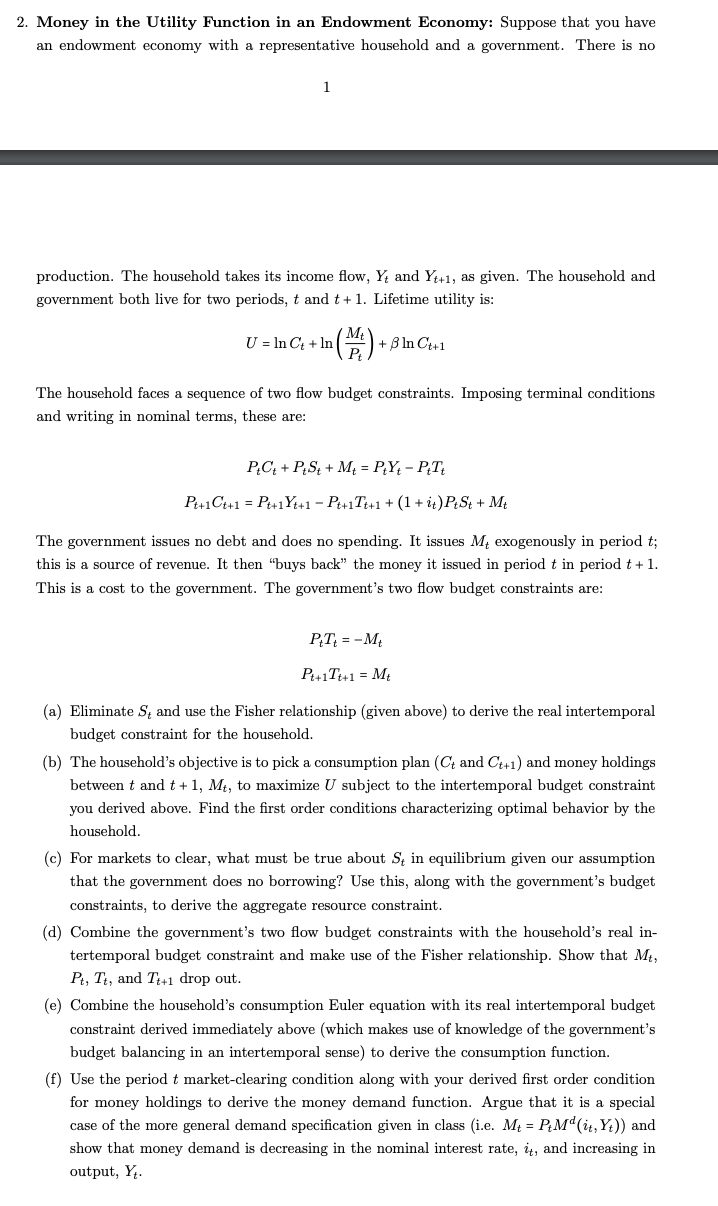
2. Money in the Utility Function in an Endowment Economy: Suppose that you have an endowment economy with a representative household and a government. There is no 1 production. The household takes its income flow, Yt and Yt+1, as given. The household and government both live for two periods, t and t+1. Lifetime utility is: U=lnCt+ln(PtMt)+lnCt+1 The household faces a sequence of two flow budget constraints. Imposing terminal conditions and writing in nominal terms, these are: PtCt+PtSt+Mt=PtYtPtTtPt+1Ct+1=Pt+1Yt+1Pt+1Tt+1+(1+it)PtSt+Mt The government issues no debt and does no spending. It issues Mt exogenously in period t; this is a source of revenue. It then "buys back" the money it issued in period t in period t+1. This is a cost to the government. The government's two flow budget constraints are: PtTt=MtPt+1Tt+1=Mt (a) Eliminate St and use the Fisher relationship (given above) to derive the real intertemporal budget constraint for the household. (b) The household's objective is to pick a consumption plan (Ct and Ct+1) and money holdings between t and t+1,Mt, to maximize U subject to the intertemporal budget constraint you derived above. Find the first order conditions characterizing optimal behavior by the household. (c) For markets to clear, what must be true about St in equilibrium given our assumption that the government does no borrowing? Use this, along with the government's budget constraints, to derive the aggregate resource constraint. (d) Combine the government's two flow budget constraints with the household's real intertemporal budget constraint and make use of the Fisher relationship. Show that Mt, Pt,Tt, and Tt+1 drop out. (e) Combine the household's consumption Euler equation with its real intertemporal budget constraint derived immediately above (which makes use of knowledge of the government's budget balancing in an intertemporal sense) to derive the consumption function. (f) Use the period t market-clearing condition along with your derived first order condition for money holdings to derive the money demand function. Argue that it is a special case of the more general demand specification given in class (i.e. Mt=PtMd(it,Yt) ) and show that money demand is decreasing in the nominal interest rate, it, and increasing in output, Yt. 2. Money in the Utility Function in an Endowment Economy: Suppose that you have an endowment economy with a representative household and a government. There is no 1 production. The household takes its income flow, Yt and Yt+1, as given. The household and government both live for two periods, t and t+1. Lifetime utility is: U=lnCt+ln(PtMt)+lnCt+1 The household faces a sequence of two flow budget constraints. Imposing terminal conditions and writing in nominal terms, these are: PtCt+PtSt+Mt=PtYtPtTtPt+1Ct+1=Pt+1Yt+1Pt+1Tt+1+(1+it)PtSt+Mt The government issues no debt and does no spending. It issues Mt exogenously in period t; this is a source of revenue. It then "buys back" the money it issued in period t in period t+1. This is a cost to the government. The government's two flow budget constraints are: PtTt=MtPt+1Tt+1=Mt (a) Eliminate St and use the Fisher relationship (given above) to derive the real intertemporal budget constraint for the household. (b) The household's objective is to pick a consumption plan (Ct and Ct+1) and money holdings between t and t+1,Mt, to maximize U subject to the intertemporal budget constraint you derived above. Find the first order conditions characterizing optimal behavior by the household. (c) For markets to clear, what must be true about St in equilibrium given our assumption that the government does no borrowing? Use this, along with the government's budget constraints, to derive the aggregate resource constraint. (d) Combine the government's two flow budget constraints with the household's real intertemporal budget constraint and make use of the Fisher relationship. Show that Mt, Pt,Tt, and Tt+1 drop out. (e) Combine the household's consumption Euler equation with its real intertemporal budget constraint derived immediately above (which makes use of knowledge of the government's budget balancing in an intertemporal sense) to derive the consumption function. (f) Use the period t market-clearing condition along with your derived first order condition for money holdings to derive the money demand function. Argue that it is a special case of the more general demand specification given in class (i.e. Mt=PtMd(it,Yt) ) and show that money demand is decreasing in the nominal interest rate, it, and increasing in output, Yt







